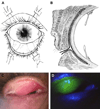Amniotic membrane transplantation as a new therapy for the acute ocular manifestations of Stevens-Johnson syndrome and toxic epidermal necrolysis
- PMID: 19699503
- PMCID: PMC2853888
- DOI: 10.1016/j.survophthal.2009.03.004
Amniotic membrane transplantation as a new therapy for the acute ocular manifestations of Stevens-Johnson syndrome and toxic epidermal necrolysis
Abstract
Stevens-Johnson syndrome and its more severe variant, toxic epidermal necrolysis, have relatively low overall incidence; however, this disease presents with high morbidity and mortality. The majority of patients develop ocular inflammation and ulceration at the acute stage. Due to the hidden nature of these ocular lesions and the concentration of effort toward life-threatening issues, current acute management has not devised a strategy to preclude blinding cicatricial complications. This review summarizes recent literature data, showing how sight-threatening corneal complications can progressively develop from cicatricial pathologies of lid margin, tarsus, and fornix at the chronic stage. It illustrates how such pathologies can be prevented with the early intervention of cryopreserved amniotic membrane transplantation to suppress inflammation and promote epithelial healing at the acute stage. Significant dry eye problems and photophobia can also be avoided with this intervention. This new therapeutic strategy can avert the catastrophic ophthalmic sequelae of this rare but devastating disease.
Figures




Similar articles
-
Correlation of corneal complications with eyelid cicatricial pathologies in patients with Stevens-Johnson syndrome and toxic epidermal necrolysis syndrome.Ophthalmology. 2005 May;112(5):904-12. doi: 10.1016/j.ophtha.2004.11.035. Ophthalmology. 2005. PMID: 15878074
-
Treatment of acute Stevens-Johnson syndrome and toxic epidermal necrolysis using amniotic membrane: a review of 10 consecutive cases.Ophthalmology. 2011 May;118(5):908-14. doi: 10.1016/j.ophtha.2011.01.046. Epub 2011 Mar 26. Ophthalmology. 2011. PMID: 21440941
-
Amniotic membrane transplantation in acute phase of toxic epidermal necrolysis with severe corneal involvement.Ophthalmology. 2006 Jan;113(1):126-32. doi: 10.1016/j.ophtha.2005.09.001. Epub 2005 Dec 1. Ophthalmology. 2006. PMID: 16324747
-
The ophthalmologic management of acute Stevens-Johnson syndrome.Ocul Surf. 2008 Apr;6(2):87-95. doi: 10.1016/s1542-0124(12)70273-2. Ocul Surf. 2008. PMID: 18418506 Review.
-
Toxic epidermal necrolysis in a 15-month-old girl successfully treated with amniotic membrane transplantation.J AAPOS. 2012 Oct;16(5):478-80. doi: 10.1016/j.jaapos.2012.05.011. J AAPOS. 2012. PMID: 23084389 Review.
Cited by
-
Corneal stem cells and tissue engineering: Current advances and future perspectives.World J Stem Cells. 2015 Jun 26;7(5):806-14. doi: 10.4252/wjsc.v7.i5.806. World J Stem Cells. 2015. PMID: 26131311 Free PMC article. Review.
-
The use of self-retained, cryopreserved amniotic membrane for the treatment of Sjögren syndrome: a case series.Digit J Ophthalmol. 2019 Jun 8;25(2):21-25. doi: 10.5693/djo.01.2019.02.005. eCollection 2019. Digit J Ophthalmol. 2019. PMID: 31327933 Free PMC article.
-
The Preparation and Clinical Efficacy of Amnion-Derived Membranes: A Review.J Funct Biomater. 2023 Oct 20;14(10):531. doi: 10.3390/jfb14100531. J Funct Biomater. 2023. PMID: 37888195 Free PMC article. Review.
-
Epidermal necrolysis French national diagnosis and care protocol (PNDS; protocole national de diagnostic et de soins).Orphanet J Rare Dis. 2018 Apr 10;13(1):56. doi: 10.1186/s13023-018-0793-7. Orphanet J Rare Dis. 2018. PMID: 29636107 Free PMC article.
-
Toxic epidermal necrolysis with ocular involvement following vaccination for hemorrhagic fever with renal syndrome.Yonsei Med J. 2012 Jan;53(1):228-30. doi: 10.3349/ymj.2012.53.1.228. Yonsei Med J. 2012. PMID: 22187258 Free PMC article.
References
-
- Aihara Y, Ito R, Ito S, et al. Toxic epidermal necrolysis in a child successfully treated with cyclosporin A and methyl-prednisolone. Pediatr Int. 2007 Oct;49(5):659–662. - PubMed
-
- Arevalo JM, Lorente JA, Gonzalez-Herrada C, Jimenez-Reyes J. Treatment of toxic epidermal necrolysis with cyclosporin A. J Trauma. 2000;48(3):473–478. - PubMed
-
- Arora R, Mehta D, Jain V. Amniotic membrane transplantation in acute chemical burns. Eye. 2005 Mar;19(3):273–278. - PubMed
-
- Arstikaitis MJ. Ocular aftermath of Stevens-Johnson syndrome. Arch Ophthalmol. 1973 Nov;90(5):376–379. - PubMed
Publication types
MeSH terms
Grants and funding
LinkOut - more resources
Full Text Sources
Medical

